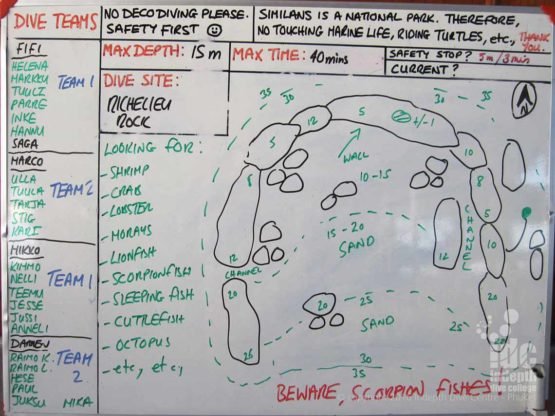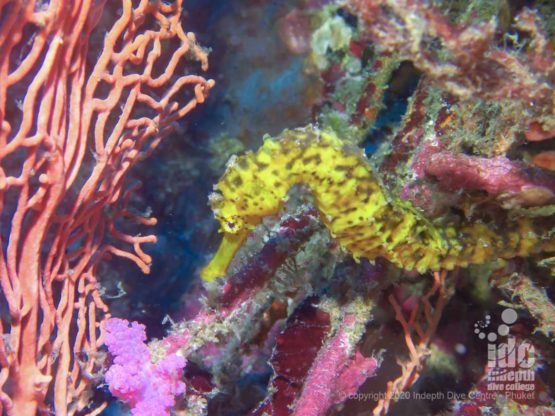
Richelieu Rock / Hin Plo Naam: a True Legend!
Arguably the most famous dive site in Thailand, Richelieu Rock is a massive underwater rock formation rising up from 35m to the surface. Richelieu Rock is located mid-ocean approximately 30 miles North East of Koh Tachai and approximately 12 miles to the East of Surin. And as such, Richelieu Rock is part of The Surin Islands. Richelieu Rock is known world-wide for it’s unbelievable diversity of marine life from the smallest of Nudibranchs to the largest of Manta Rays and Whale Sharks!
Richelieu Rock was discovered by diving pioneer Jacques-Yves Cousteau with the help of local fishermen. However, the origin of the name "Richelieu Rock" is disputed. Some say it was named by Cousteau after the red color of Cardinal Richelieu's robe. This is due to the mass of red and purple colours of the soft corals on the reef. While other people claim it was named after General Richelieu who was a commander in the Royal Thai Navy.
And since you will want be at your best when you dive Richelieu Rock, you can always dive Phuket first to get yourself back into Dive Mode on a Phuket Day Trip if needed!
Whatever the origin of the name, Richelieu Rock is one of Asia’s most famous scuba diving sites. And you can see pretty much anything found in the Andaman Sea here. As such, it is a divers and photographers paradise!
Richelieu Rock: Thailand’s best Dive Site!
Richelieu Rock is shaped like a horse shoe with the tips of the horse shoe pointing South. And at low tide you can see approximately 1m of the rock sticking out of the water. However, at high tide nothing can be seen from the surface. Although this can change, at the time of writing, there is just one mooring line at Richelieu Rock. This is located on the Eastern Side of the horseshoe.
The current normally runs from North to South and obviously visibility can vary from dive to dive. This is normally poorest after a full moon or new moon when there can be a plankton bloom. And while the dive site may seem small, it can even vary on the dive with one side the dive site having 30m+ viz and the other less than 5m.
The dive site drops off to a depth of around 35m on the outside of the horseshoe. You will see the inside is between 25-5m consisting mainly of a steep wall with some other rocks on the Eastern and Northern sides. Now if you use the mooring line to descend, (or at least use it as a visual reference), you would normally work you way around the outside of the dive site. Then usually ending the dive in the middle if the current will allow. You will find beautiful soft corals, anemones and sea fans cover the dive site in the deeper waters. This really is spectacular and unbelievably colorful.
You can see almost anything found in the Andaman Sea at Richelieu Rock, from the smallest to the largest creatures and it truly is a photographer’s paradise.
What fish species can you expect to see?
If you start Richelieu Rock in the mid water you can expect to see a large school of Chevron Barracuda. In addition, inside the horseshoe you will find huge schools of Snappers and Fusiliers. Then, close to the main rocks you can see all species of Angelfish you find in the Andaman Sea. This is also a great place to spot the rare Juvenile Emperor and Blue Ringed Angelfish. There are plenty of species of Anemone fish here including an abundance of tomato Anemone Fish. In addition you will also find that Cuttlefish and Octopus are frequently seen here.
Also there are many species of Moray Eels at Richelieu Rock. Therefore, if you take your time and look, in almost every crack, you will find the small White Eyed Moray and Giant Moray Eel. You will also find Fibrillated Morays, Zebra Morays and Honeycomb Morays. Pipefish are a plenty, in particular the Janns (cleaner) pipefish and Multibar Pipefish. and also the very popular Ornate Ghost Pipefish and Tiger Tail Seahorses. Richelieu Rock is home to all of them but be warned, you will not see them at the Similan Islands. So make the most of this opportunity.
On the North West Corner of this spectacular dive site you can often find very large Malabar Groupers as well. You will see scorpion fish everywhere, so if you are stopping to take a photo, please make sure you do no touch one as you steady yourself against the rock. And you will find another treat awaiting you throughout the dive site, huge groups of extremely large Lion Fish.
Richelieu Rock Shrimps and Nudibranch species
Richelieu Rock also has the very special Harlequin Shrimps but you have to look very closely to find these. But in every crack and crevice you can expect to see Banded Boxer Shrimps, Cleaner Shrimps and Dancing Durban Shrimps. In addition, there are also many Peacock Mantis shrimps which can found to be scuttling around on the ocean floor.
In water as shallow as 1m down to any depth you will find a very wide range of Nudibranchs. Japanese Pineapple Fish have also been spotted here, but they are very rare. There are many other species that await you. In fact, we could actually write pages on the awesome dives we have made and the sheer amount of cool stuff we have seen here!
Rebreather diving opportunities
Rebreather Divers, as with open circuit divers and photographers, will also find themselves in paradise. The depths and layout of Richelieu Rock make this an incredible Rebreather dive. And when all the open circuit divers head up after 40-50 minutes, rebreather divers will still have another couple of hours dive time left. Yes this is one of reasons we dive rebreathers!
This actually works out very well as most Richelieu Rock Liveaboards normally do at least 2 dives here. So rebreather divers can do 1 x 3 hour Rebreather dive while the open circuit divers do their first dive. Then have their surface interval and make the 2nd dive. Rebreather divers can stay underwater the whole time.
Remember to take it slowly to get the most from your dive. Your Dive Guide should be able to find the rarer species such as Harlequin Shrimps and Sea Horses as they do not tend to move far. If you are lucky you may also see a Leopard Shark or Guitar Shark at Richelieu Rock.
Ending the dive
Richelieu Rock can be very busy with many dinghy’s and large boats picking up divers, so please do try to end your dive away from the main rock. And ALWAYS use a safety marker.
Finally, at Richelieu Rock, ALWAYS keep an eye into the blue for a Manta Ray or Whale Shark. And YES, it is possible to see both of these at the same time which is truly amazing!














